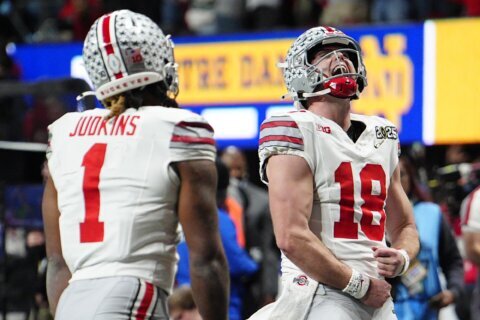Ra’Shaad Samples was a reticent and newly appointed student-assistant, shagging balls at practice with a group of wide receivers who were recently his teammates, when he received one of his first important lessons about coaching.
“Ra’Shaad, you have to talk to coach,” Samples recalls then-Houston coach Tom Herman yelling at him from across a practice field.
The 29-year-old Samples has come a long way since. Now heading into his first season as running backs coach at No. 3 Oregon, he has made stops at Texas, SMU, TCU, the Los Angeles Rams — where he was the youngest position coach in the NFL — and Arizona State.
This tumultuous and uncertain period of college football, with rules about player compensation and transfers seemingly changing every six months, has made more than a few coaches — including Nick Saban — question whether the job is really for them anymore.
For younger coaches like Samples — the potential head coaches of the future — evolution is everything. The 30-something head coaches Samples has worked for — the Rams’ Sean McVay, Arizona State’s Kenny Dillingham and now Oregon’s Dan Lanning — have taught him: It’s not about keeping up with trends, but being a trendsetter.
“I actually think about that all the time,” Samples said. “I think the most important part of staying competitive in college football is fluidity and being able to change with the times.”
In the past that meant being willing to try new offensive and defensive schemes, incorporating social media into a recruiting strategy or embracing fourth-down analytics.
Now, as college football becomes more like the pros, the fundamental relationship between player and coach is changing. As is a program’s organizational chart. Recruiting is becoming more transactional and talent retention is as important — if not more so — than talent acquisition.
College football head coaches have long been compared to CEOs of large companies, but as these operations grow the need to reliniquish or delegate control increases — but how much?
“Some coaches are way more hands on than others, but there are so many more hats (to wear) I think the quality of help that you have is really important in hiring good people and being excited and surprised with how they do their job,” said the 38-year-old Lanning, who is 22-5 in two seasons leading the Ducks. “But I also know that if it’s important to me as a head coach, I better be involved in it in some way. And if I’m not, then it’s probably not going to be to the standard.”
Dollars and sense
Since 2021, when the NCAA lifted its ban on athletes using their names, images and likenesses to earn money, millions of dollars have flowed to major college football players through booster-supported NIL collectives.
The next evolution of college sports is revenue-sharing with athletes.
“There’s a business relationship that has to be had between players and coaches now that didn’t exist,” Samples said.
Dillingham, who at 34 is the youngest head coach in major college football, said money doesn’t change everything. Where a player decides to play is still often a decision made with parents and loved ones, weighing an assortment of factors that NFL players do not.
“So, it’s how do you manage 18- to 22-year olds?” Dillingham said. “That’ll never change regardless of how much money the kids make. May there be more obstacles with it? Yes.”
Relationships still matter in recruiting, Lanning said.
“I think parents and players are protecting their best interests and not going to hurt themselves by going to a place, but they’re certainly not picking just a place that gives them the best deal,” Lanning said. “It’s about the relationship to get a seat at the table.”
Still, with players now able to switch schools easier than ever before, those connections need to be made more quickly to either attract transfers or to keep the players you have from leaving.
“We talk about how do you microwave the relationship process?” said Herman, who is in his second season as head coach at FAU.
Dillingham said: “For years it was how do I get somebody in the door. And now it’s how do I get somebody to stay in the house. And those are two different models.”
Samples, a former blue-chip recruit from Dallas whose father, Reginald, is a Texas high school coaching legend, has a reputation as an ace recruiter. As an assistant under Sonny Dykes, Ra’Shaad Samples was key in helping SMU sign its best class in decades in 2021.
“His gift is his relatability,” Herman said. “His gift is his relationships.”
True CEO
Major college football teams are already transitioning to NFL-style personnel departments, hiring general managers and staffers whose sole focus is scouting and roster management. Some are dabbling in salary cap management, too, with an eye toward the looming revenue-sharing system.
Herman said he could see a future where, just like in the NFL, a GM moves above the coach on a college program’s org chart.
As the organization grows, a head coach’s role will be more focused on tying the different aspects together.
“I think you’re going to truly have to make it a CEO model and develop branches of governing your program,” Samples said. “I think more than ever, the head coach’s job outside of Xs and Os is going to be able to create systems and implement systems and implement playbooks, not just for the offense or the defense, but implement playbooks for player development.”
Dillingham talks about spotting trends and building upon them. It’s not enough to be a step ahead.
“Everybody looks for what’s next?” Samples said. “What’s the answer to what’s next? You know, what’s next after what’s next?”
___
Follow Ralph D. Russo at https://twitter.com/ralphDrussoAP
___
AP college football: https://apnews.com/hub/college-football
Copyright © 2025 The Associated Press. All rights reserved. This material may not be published, broadcast, written or redistributed.








